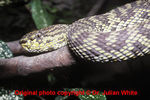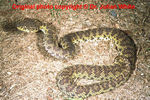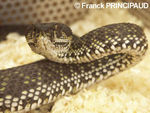|
Trimeresurus purpureomaculatus
|
![Trimeresurus purpureomaculatus ( Mangrove Pit Viper ) [ Original photo copyright © Dr Anita Malhotra ]](images/snakes/SNP01141.jpg)
|
|
Family: Viperidae
|
|
Subfamily: Crotalinae
|
|
Genus: Trimeresurus
|
|
Species: purpureomaculatus
|
Common Names
Mangrove Pit Viper , Shore Pit Viper , Gray's Pit Viper , Purple-spotted Pit Viper
|
Local Names
Ular Kapak Bakau
|
Region
Indian Sub-continent + Southeast Asia
|
Countries
Bangladesh, Indonesia, India, Malaysia, Myanmar, Singapore, Thailand
|
|

|
|
|
|
Taxonomy and Biology
|
|
Adult Length: 0.40 m
|
General Shape
Small in length, slender, cylindrical bodied snake with a medium length prehensile tail. Can grow to a maximum of about 0.67 metres for males and about 0.90 metres for females. Head is large, longer than broad, triangular shaped and distinct from neck. Eyes are medium in size with vertically elliptical pupils. Dorsal scales are strongly keeled. Dorsal scale count usually 25 - ( 23 to 29 ) - ( 19 or 21 ) with males usually with 23 or 25 midbody scale rows and females usually with 25 or 27 midbody scale rows.
|
Habitat
Coastal mangrove and swamp forest. Particularly common on some smaller offshore islands. Has also been found in inland bamboo jungle at elevations up to about 2000 metres.
|
Habits
Arboreal and restricted to the lower canopy.
|
Prey
Feeds mainly on ground and tree rodents, tree frogs, lizards and small birds.
|
|
|
|
Venom
|
General: Venom Neurotoxins
Probably not present
|
General: Venom Myotoxins
Unknown
|
General: Venom Procoagulants
Probably present
|
General: Venom Anticoagulants
Possibly present
|
General: Venom Haemorrhagins
Present, clinical significance uncertain
|
General: Venom Nephrotoxins
Unknown
|
General: Venom Cardiotoxins
Probably not present
|
General: Venom Necrotoxins
Unknown
|
General: Venom Other
Unknown
|
|
|
|
Clinical Effects
|
General: Dangerousness
Severe envenoming possible, potentially lethal
|
|
General: Rate of Envenoming: Unknown but likely to be moderate
|
|
General: Untreated Lethality Rate: Unknown but has caused deaths
|
General: Local Effects
Marked local effects; pain, severe swelling, bruising, blistering, necrosis
|
General: Local Necrosis
Potentially may occur
|
General: General Systemic Effects
Variable non-specific effects which may include headache, nausea, vomiting, abdominal pain, diarrhoea, dizziness, collapse or convulsions
|
General: Neurotoxic Paralysis
Unlikely to occur
|
General: Myotoxicity
Not likely to occur
|
General: Coagulopathy & Haemorrhages
Uncommon to rare, but may be moderate to severe coagulopathy
|
General: Renal Damage
Insufficient clinical reports to know
|
General: Cardiotoxicity
Unlikely to occur
|
General: Other
Insufficient clinical reports to know
|
|
|
|
First Aid
|
|
Description: First aid for bites by Viperid snakes likely to cause significant local injury at the bite site (see listing in Comments section).
|
Details
1. After ensuring the patient and onlookers have moved out of range of further strikes by the snake, the bitten person should be reassured and persuaded to lie down and remain still. Many will be terrified, fearing sudden death and, in this mood, they may behave irrationally or even hysterically. The basis for reassurance is the fact that many venomous bites do not result in envenoming, the relatively slow progression to severe envenoming (hours following elapid bites, days following viper bites) and the effectiveness of modern medical treatment.
2. The bite wound should not be tampered with in any way. Wiping it once with a damp cloth to remove surface venom is unlikely to do much harm (or good) but the wound must not be massaged.
3. All rings or other jewellery on the bitten limb, especially on fingers, should be removed, as they may act as tourniquets if oedema develops.
4. The bitten limb should be immobilised as effectively as possible using an extemporised splint or sling; if available, crepe bandaging of the splinted limb is an effective form of immobilisation.
5. If there is any impairment of vital functions, such as problems with respiration, airway, circulation, heart function, these must be supported as a priority. In particular, for bites causing flaccid paralysis, including respiratory paralysis, both airway and respiration may be impaired, requiring urgent and prolonged treatment, which may include the mouth to mask (mouth to mouth) technique of expired air transfer. Seek urgent medical attention.
6. Do not use Tourniquets, cut, suck or scarify the wound or apply chemicals or electric shock.
7. Avoid peroral intake, absolutely no alcohol. No sedatives outside hospital. If there will be considerable delay before reaching medical aid, measured in several hours to days, then give clear fluids by mouth to prevent dehydration.
8. If the offending snake has been killed it should be brought with the patient for identification (only relevant in areas where there are more than one naturally occurring venomous snake species), but be careful to avoid touching the head, as even a dead snake can envenom. No attempt should be made to pursue the snake into the undergrowth as this will risk further bites.
9. The snakebite victim should be transported as quickly and as passively as possible to the nearest place where they can be seen by a medically-trained person (health station, dispensary, clinic or hospital). The bitten limb must not be exercised as muscular contraction will promote systemic absorption of venom. If no motor vehicle or boat is available, the patient can be carried on a stretcher or hurdle, on the pillion or crossbar of a bicycle or on someone's back.
10. Most traditional, and many of the more recently fashionable, first aid measures are useless and potentially dangerous. These include local cauterization, incision, excision, amputation, suction by mouth, vacuum pump or syringe, combined incision and suction ("venom-ex" apparatus), injection or instillation of compounds such as potassium permanganate, phenol (carbolic soap) and trypsin, application of electric shocks or ice (cryotherapy), use of traditional herbal, folk and other remedies including the ingestion of emetic plant products and parts of the snake, multiple incisions, tattooing and so on.
|
|
|
|
Treatment
|
Treatment Summary
Bites by this species cause moderate, possibly major local & systemic effects, including coagulopathy/bleeding. Assess & admit all major cases. Antivenom therapy is probably the key treatment, especially for coagulopathy.
|
Key Diagnostic Features
Local pain, swelling, blistering, necrosis + coagulopathy, bleeding
|
General Approach to Management
All cases should be treated as urgent & potentially lethal. Rapid assessment & commencement of treatment including appropriate antivenom (if indicated & available) is mandatory. Admit all cases.
|
Antivenom Therapy
Antivenom is the key treatment for systemic envenoming. Multiple doses may be required.
|
| 1. Antivenom Code: SAsCRI01
|
|
Antivenom Name: Polyvalent Anti Snake Venom Serum
|
|
Manufacturer: Central Research Institute
|
|
Phone: ++91-1-792-72114
|
|
Address: Kasauli (H.P.) 173204
|
|
Country: India
|
| 2. Antivenom Code: SAsTRC01
|
|
Antivenom Name: Green Pit Viper Antivenin
|
|
Manufacturer: Science Division, Thai Red Cross Society
|
|
Phone: ++66-2-252-0161 (up to 0164)
|
Address: Queen Saovabha Memorial Institute
1871 Rama IV Road
Pathumwan
Bangkok 10330
|
|
Country: Thailand
|
| 3. Antivenom Code: SAsSII01
|
|
Antivenom Name: SII Polyvalent Antisnake Venom Serum ( lyophilized )
|
|
Manufacturer: Serum Institute of India Ltd.
|
|
Phone: +91-20-26993900
|
Address: 212/2, Hadapsar,
Off Soli Poonawalla Road,
Pune-411042. India
|
|
Country: India
|
| 4. Antivenom Code: SAsSII02
|
|
Antivenom Name: SII Bivalent Antisnake Venom Serum ( lyophilized )
|
|
Manufacturer: Serum Institute of India Ltd.
|
|
Phone: +91-20-26993900
|
Address: 212/2, Hadapsar,
Off Soli Poonawalla Road,
Pune-411042. India
|
|
Country: India
|
|
|
|
Images
|

|

|

|

|
|
|
|
Trimeresurus purpureomaculatus ( Mangrove Pit Viper ) [ Original photo copyright © Dr Anita Malhotra ]
|
Trimeresurus purpureomaculatus ( Mangrove Pit Viper ) [ Original photo copyright © Dr Julian White ]
|
Trimeresurus purpureomaculatus ( Mangrove Pit Viper ) [ Original photo copyright © Dr Julian White ]
|
Trimeresurus purpureomaculatus ( Mangrove Pit Viper ) [ Original photo copyright © Franck Principaud]
|
|
|
|
|
|



